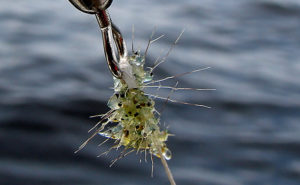Spiny Water Flea
Spiny Water Flea (SWF)
Where are SWF from and how did they get here?
SWF were introduced to the great lakes via ship ballast water from Europe in the 1980s. Because they are so small and translucent, they are virtually invisible.

SWF are very tiny. Here they are compared in size to a finger tip.
How do I identify SWF?
SWF are only 1/4”-1/2” long with a translucent body. They are very difficult to spot unless they are in a cluster, as they tend to form on fishing lines and downrigger cables. They are primarily characterized by a very long spine that extends from the abdomen. They also have a dark black eye.
Please contact our Water Program Coordinator if you think you have found SWF.

Note the long tail spine and large black eye.
How do SWF affect Wisconsin water bodies?
SWF are predatory zooplankton. They eat smaller zooplankton, and are therefore direct competitors with juvenile fish for food. The smaller zooplankton SWF eats are also consumers of algae, and in some lakes infested with SWF, there may be a drop in water clarity due to increase in algae growth.
Many young fish cannot eat SWF due to their long pointy tails.

SWF are often to long and pointy for small fish to eat.
What can be done once SWF enter a water body?
Unfortunately there are no control methods for SWF at this time. The best method of treatment is preventing them from entering a water body in the first place. Because SWF are virtually invisible, it is important to take care to drain all water from boats before leaving a landing, and to clean all mud off anchors, ropes, and trailers. SWF eggs, which are tiny, can be hidden in mud stuck to equipment.

Cluster of SWF on a fishing line.
Additional Resources
Manitowish Waters Lakes Association
Wisconsin DNR Aquatic Invasive Species
Citizen Lake Monitoring Network: Get Involved!
Great Lakes Indian Fish & Wildlife Commission (GLIFWC) Invasive Species Area Maps
US Geological Survey Invasive Species Research
Vilas County Land and Water Conservation Department
Invasive Plants Association of Wisconsin
Books:
Available for loan.
Lake Plants You Should Know- A Visual Field Guide. University of Wisconsin- Extension.
Aquatic Plants of the Upper Midwest- A Photographic Field Guide To Our Underwater Forests.Written by: Paul Skawinski.
Through the Looking Glass- A Field Guide to Aquatic Plants. Written by: Susan Borman, Robert Korth, and Jo Temte.
Saving Our Lakes and Streams. Written by: James A. Brakken.
Your Help Is Needed
Curly leaf pondweed has been found in the Manitowish Waters Chain. Please keep your eyes open and let us know if you see this aquatic invasive plant along your shorelines or docks. Additionally, please check your boats and props to prevent the spread!
Citizen AIS Lake Monitoring
Join a crew to search for suspicious-looking species (plant or animal). Keep your eyes peeled and report any sightings to us.
Clean Boats Clean Waters
Educate boaters at landings and inspect boats and trailers.
Volunteer today, to protect our waters tomorrow.
Email: water@discoverycenter.net
Phone: (715) 543-2085
AIS of the Month
September: Mystery Snails
August: Eurasian Water Milfoil
July: Purple Loosestrife
June: Curly Leaf Pondweed
